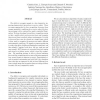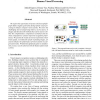FGR
2008
IEEE
15 years 7 months ago
2008
IEEE
Linear Discriminant Analysis (LDA) has been a popular method for feature extracting and face recognition. As a supervised method, it requires manually labeled samples for training...
131
click to vote
FGR
2008
IEEE
15 years 7 months ago
2008
IEEE
Partial occlusions in face images pose a great problem for most face recognition algorithms. Several solutions to this problem have been proposed over the years – ranging from d...
116
click to vote
FGR
2008
IEEE
15 years 7 months ago
2008
IEEE
We describe an expression-invariant method for face recognition by fitting an identity/expression separated 3D Morphable Model to shape data. The expression model greatly improve...
109
click to vote
FGR
2008
IEEE
15 years 7 months ago
2008
IEEE
Registration of facial features is a significant step towards a complete solution of the face recognition problem. We have built a general framework for detecting a set of indivi...
107
click to vote
FGR
2008
IEEE
15 years 7 months ago
2008
IEEE
In this paper, we present a real-time 3D pointing gesture recognition algorithm for natural human-robot interaction (HRI). The recognition errors in previous pointing gesture reco...
112
click to vote
FGR
2008
IEEE
15 years 7 months ago
2008
IEEE
The ability to recognize people is a key element for improving human-robot interaction in service robots. There are many approaches for face recognition; however, these assume unr...
112
click to vote
FGR
2008
IEEE
15 years 7 months ago
2008
IEEE
In this paper, we describe a dynamic Bayesian network or DBN based approach to both two-hand gestures and onehand gestures. Unlike wired glove-based approaches, the success of cam...
128
click to vote
FGR
2008
IEEE
15 years 7 months ago
2008
IEEE
We explore the opportunity to harness electroencephalograph (EEG) signals generated during human visual processing to enhance computer vision systems. We review the challenging ta...
104
Voted
FGR
2008
IEEE
15 years 7 months ago
2008
IEEE
Many facial image analysis methods rely on learningbased techniques such as Adaboost or SVMs to project classifiers based on the selection of local image filters (e.g., Haar and...
117
click to vote
FGR
2008
IEEE
15 years 7 months ago
2008
IEEE
In this article we explore the use of methodologies for 3D reconstruction from multiple images to recognize faces. We try to devise a strategy to tackle the problem of recognizing...


